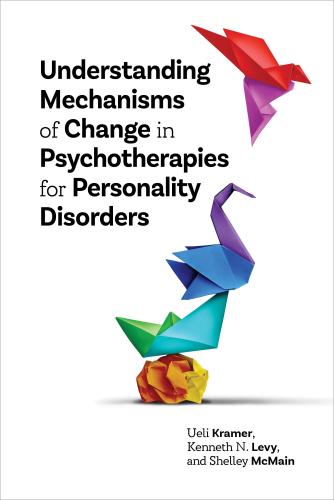Understanding Mechanisms Of Change In Psychotherapies...
| Item Information | |
|---|---|
| Item#: | 9781433836718 |
| Author | Kramer, et al.. |
This book presents a holistic approach to treating patients with personality disorders that seeks to inspire psychotherapists and encourage innovation.
Focusing on core mechanisms of change that span different therapeutic approaches, this book invites clinicians and researchers to join a dialogue with the authors, as they examine personality disorders from different theoretical perspectives, including dialectical behavior therapy, transference‑focused therapy, plan analysis, clarification‑oriented, and emotion‑focused therapies.
The authors explore five functional domains that underlie assessment and treatment for personality disorders: emotion dysregulation, disturbed social interaction, identity problems, impulsivity, and cognitive disturbances. Each domain is analyzed through an in‑depth case example, with case conceptualizations and the careful evaluation of clinical decisions that must be made at key points in therapy. The authors then compare their different approaches, emphasizing commonalities among them while also pointing out notable differences.
They also offer clear and compelling recommendations for maintaining and strengthening the therapeutic alliance. The final chapter synthesizes key takeaways from across the book to create a clear path towards enhancing clinical practice.
Focusing on core mechanisms of change that span different therapeutic approaches, this book invites clinicians and researchers to join a dialogue with the authors, as they examine personality disorders from different theoretical perspectives, including dialectical behavior therapy, transference‑focused therapy, plan analysis, clarification‑oriented, and emotion‑focused therapies.
The authors explore five functional domains that underlie assessment and treatment for personality disorders: emotion dysregulation, disturbed social interaction, identity problems, impulsivity, and cognitive disturbances. Each domain is analyzed through an in‑depth case example, with case conceptualizations and the careful evaluation of clinical decisions that must be made at key points in therapy. The authors then compare their different approaches, emphasizing commonalities among them while also pointing out notable differences.
They also offer clear and compelling recommendations for maintaining and strengthening the therapeutic alliance. The final chapter synthesizes key takeaways from across the book to create a clear path towards enhancing clinical practice.
Short Description
This book invites readers to join a transtheoretical dialogue between the three authors about a holistic approach to treating personality disorders.
Table of Contents
Introduction. Synthesizing Diverse Perspectives on Personality Disorders
Chapter 1. The Importance of Developing a Focus on Mechanisms of Change in Psychotherapy
Chapter 2. Personality Disorders: A Conceptualization in Functional Domains
Chapter 3. The First Session of Psychotherapy and Getting Started in Treatment
Chapter 4. Moving From Emotional Dysregulation to Emotional Balance
Chapter 5. Moving From Problematic Social Interactions to Interpersonal Effectiveness
Chapter 6. Moving From Identity Diffusion to an Integrated Sense of Self
Chapter 7. Moving From Impulsive Behavior to Self-Reflection
Chapter 8. Moving From Cognitive–Perceptual Disturbances to Coherent and Reality-Based Narratives
Chapter 9. Challenges in the Therapeutic Relationship and How to Use Them Productively in Psychotherapy
Chapter 10. Discussing Mechanisms of Change in Psychotherapies for Personality Disorders
References
Index
About the Authors
Chapter 1. The Importance of Developing a Focus on Mechanisms of Change in Psychotherapy
Chapter 2. Personality Disorders: A Conceptualization in Functional Domains
Chapter 3. The First Session of Psychotherapy and Getting Started in Treatment
Chapter 4. Moving From Emotional Dysregulation to Emotional Balance
Chapter 5. Moving From Problematic Social Interactions to Interpersonal Effectiveness
Chapter 6. Moving From Identity Diffusion to an Integrated Sense of Self
Chapter 7. Moving From Impulsive Behavior to Self-Reflection
Chapter 8. Moving From Cognitive–Perceptual Disturbances to Coherent and Reality-Based Narratives
Chapter 9. Challenges in the Therapeutic Relationship and How to Use Them Productively in Psychotherapy
Chapter 10. Discussing Mechanisms of Change in Psychotherapies for Personality Disorders
References
Index
About the Authors

